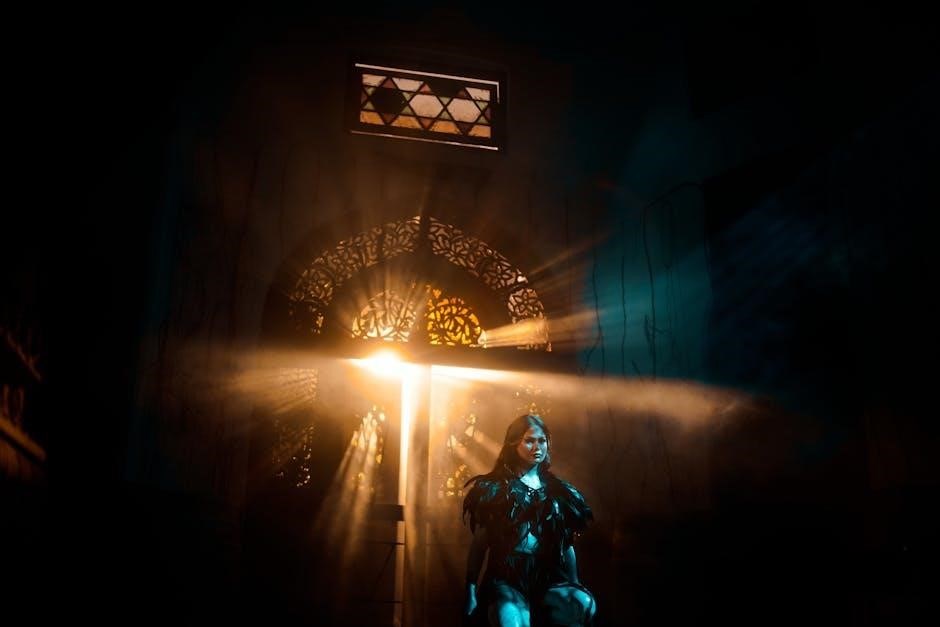La Marr Jurelle Bruce’s work explores the intersection of madness, creativity, and racial identity, offering a provocative look at embracing madness as a transformative force without self-destruction.
1.1 Overview of the Concept of Madness
Madness, as explored in How to Go Mad Without Losing Your Mind, is a multifaceted concept that transcends traditional notions of mental instability. It embodies both chaos and creativity, often manifesting as a disruptive yet transformative force. Rooted in the black radical tradition, madness is reimagined as a form of resistance and innovation, challenging societal norms and power structures. The book highlights how embracing madness constructively can lead to profound personal and societal change, balancing the fine line between creative genius and mental well-being.
1.2 Importance of Embracing Madness Constructively
Embracing madness constructively allows individuals to harness its transformative power without succumbing to self-destruction. By reimagining madness as a creative and resistive force, particularly within the black radical tradition, one can tap into its potential for innovation and societal critique. This approach encourages balancing chaos with clarity, fostering a mindset that navigates the edge of instability while maintaining mental well-being. Constructive madness becomes a tool for challenging norms, sparking creativity, and driving meaningful change, both personally and societally.
1.3 Purpose of the Article
The purpose of How to Go Mad Without Losing Your Mind is to challenge conventional notions of madness and invite readers to reconsider its role in creativity, identity, and societal change. Through personal narratives and historical analysis, the book aims to redefine madness as a potentially transformative force rather than a solely destructive one.
By blending critical theory with radical creativity, the text encourages readers to embrace their unique experiences and explore madness as a means of ethical and innovative thinking. It seeks to inspire a deeper understanding of how madness can be harnessed constructively.

Historical Context of Madness
Madness has historically been intertwined with creativity and social change, often viewed as both a curse and a catalyst for radical thinking across cultures and eras.
2.1 The Black Radical Tradition and Madness
The Black Radical Tradition has long embraced madness as a form of resistance and innovation, challenging oppressive systems through unconventional thinking and radical creativity. Figures like La Marr Jurelle Bruce reimagine madness as a strategic disruption, blending personal narratives with historical context to redefine liberation. This tradition emphasizes the transformative power of madness, aligning it with the pursuit of justice and social change, rather than viewing it as a limitation. By celebrating this intersection, the Black Radical Tradition highlights madness as a catalyst for visionary thinking and collective transformation.
2.2 Historical Figures Who Embodied Madness
Historical figures like Vincent van Gogh and Virginia Woolf exemplify the complex relationship between madness and creativity. Their struggles with mental health often fueled their artistic genius, leaving lasting legacies. Van Gogh’s vibrant paintings, created amid his battles with psychosis, remain iconic, while Woolf’s literary brilliance coexisted with her depressive episodes. These figures demonstrate how madness, when channeled constructively, can lead to extraordinary contributions. Their lives highlight the delicate balance between embracing madness and maintaining mental well-being, serving as inspiration for contemporary discussions on creativity and mental health.
2.3 Evolution of Societal Views on Madness
Societal perceptions of madness have evolved significantly over time, shifting from fear and stigmatization to a more nuanced understanding. Historically, madness was often associated with moral failure or divine punishment, leading to isolation and mistreatment. The rise of asylums in the 19th century reflected a growing medicalization of madness, yet conditions remained harsh. Modern perspectives emphasize mental health awareness and destigmatization, recognizing the complexity of madness as both a challenge and a potential source of creativity. This shift highlights humanity’s gradual move toward empathy and understanding in addressing mental struggles.

Theoretical Foundations of Madness
Theoretical frameworks explore the interplay between creativity, mental health, and societal constructs, providing insights into how madness can be harnessed as a productive, transformative experience.

3.1 Cesare Lombroso’s Theory of Genius and Madness
Cesare Lombroso’s theory posits that genius and madness are interconnected, stemming from a constitutional defect. He argued that geniuses often exhibit traits associated with insanity, suggesting a biological link. While his ideas have been criticized for oversimplification, they highlight the historical fascination with the relationship between creativity and mental health. Lombroso’s work laid the groundwork for later studies exploring the psychological and neurological underpinnings of genius and madness, influencing modern debates on creativity and mental well-being.
3.2 Kay Redfield Jamison’s Research on Creativity and Mental Health
Kay Redfield Jamison’s research examines the correlation between creativity and mental health, particularly among artists and writers. Her studies reveal that many prominent figures experienced mental health struggles, such as affective disorders, which often coexisted with their creative output. Jamison’s work challenges the romanticized notion of the “tortured artist,” instead advocating for a nuanced understanding of how mental health can both inspire and hinder creativity. Her findings emphasize the importance of balancing mental well-being with creative expression, offering insights into managing madness constructively. Her work remains influential in contemporary discussions on creativity and mental health.
3.3 The Concept of “Mad Methodology”
La Marr Jurelle Bruce introduces “mad methodology” as a framework where madness becomes a deliberate approach to thinking, feeling, and creating. This concept challenges traditional norms by viewing madness not as a hindrance, but as a catalyst for innovation and critical analysis. Bruce argues that embracing madness can lead to unconventional insights and radical perspectives, particularly within the Black radical tradition. By integrating madness into methodology, individuals can explore new dimensions of creativity and social critique without losing their mental grounding, transforming madness into a constructive and ethical practice.

Practical Applications of Madness
Madness can be harnessed as a creative force, sparking innovation and fostering social critique, while maintaining mental well-being through intentional balance and constructive expression of emotions.
4.1 Using Madness as a Creative Force
Madness can be a powerful catalyst for creativity, enabling individuals to break free from conventional thinking and tap into innovative ideas. By embracing madness, one can access unexplored perspectives and channel raw emotions into artistic expression. This transformative process allows for the creation of unique and impactful works, as seen in the lives of artists like Vincent van Gogh and Jackson Pollock, who harnessed their struggles to produce groundbreaking art. Madness, when guided constructively, becomes a tool for turning chaos into beauty and disorder into meaningful creation.
4.2 Madness as a Form of Social Critique
Madness can serve as a potent form of social critique, challenging societal norms and power structures. By embracing radical perspectives, individuals can expose systemic inequalities and provoke dialogue on pressing issues. This approach, as discussed in Bruce’s work, allows madness to become a tool for questioning authority and fostering change. Historical figures and artists have used their experiences to critique societal norms, demonstrating how madness can be a catalyst for transformative discourse and political engagement, ultimately inspiring a reexamination of justice and equality in contemporary society.
4.3 Balancing Madness with Mental Well-being
Balancing madness with mental well-being requires a delicate interplay between embracing creative chaos and maintaining emotional stability. While madness can fuel innovation and social critique, it is crucial to establish boundaries to prevent self-destruction. Bruce emphasizes the importance of self-awareness and seeking support systems to navigate intense emotional and mental states. By integrating mindfulness and reflective practices, individuals can harness the power of madness without compromising their mental health, ensuring that creativity and critique coexist with personal well-being and resilience.

Cultural Significance of Madness

Madness holds profound cultural significance, inspiring creativity, social critique, and personal transformation. It challenges norms, fostering innovation and rebellion, while its portrayal in art and literature reflects societal values and struggles.
5.1 Madness in Art and Literature
Madness has long been a theme in art and literature, with creators like Van Gogh, Pollock, and Woolf expressing their struggles through their work. Writers such as Gilman and Chopin depicted madness as a response to societal oppression, while artists like Emin used their art to process mental turmoil. These works not only reflect personal experiences but also challenge societal norms, offering profound insights into the human condition. By exploring madness, artists and writers uncover the complexities of the mind, blending creativity with catharsis to produce works of enduring cultural significance.
5.2 The Role of Madness in Black Radical Art
Black radical art often employs madness as a form of resistance and liberation, challenging oppressive systems. Artists like Bruce explore madness as a creative force, blending personal narratives with historical context to critique societal structures. This approach redefines madness not as a weakness but as a powerful tool for radical expression and change. By embracing madness, Black radical artists create works that provoke thought and inspire action, fostering a deeper understanding of identity and resilience in the face of systemic oppression.
5.3 Madness as a Form of Resistance
Madness, when harnessed strategically, becomes a powerful form of resistance against oppressive systems. By embracing unconventional thought and behavior, individuals challenge societal norms and expectations. This resistance is particularly evident in Black radical art, where madness is used to critique systemic racism and oppression. Artists like La Marr Jurelle Bruce illustrate how madness can be a deliberate act of defiance, fostering new perspectives and sparking necessary conversations. It becomes a tool to dismantle structures of control, empowering individuals to reclaim their identities and voices.

Personal Narratives of Madness
La Marr Jurelle Bruce shares intimate stories of navigating madness, blending personal struggles with artistic expression, offering insights into the transformative power of embracing one’s unique journey.
6.1 La Marr Jurelle Bruce’s Personal Journey
La Marr Jurelle Bruce’s personal journey is a compelling exploration of madness, creativity, and identity. His experiences, intertwined with societal pressures and mental health struggles, illuminate the transformative power of embracing madness. Bruce’s narrative offers a unique perspective on navigating the complexities of mental health while channeling these challenges into artistic expression. His story challenges conventional notions of madness, presenting it as a force that can inspire growth and innovation. Through his journey, Bruce invites readers to reconsider their relationship with madness, fostering a deeper understanding of its potential for self-discovery and creativity.
6.2 Stories of Artists Who Navigated Madness
Throughout history, artists have often grappled with madness, channeling their struggles into groundbreaking work. Vincent van Gogh, despite his mental health battles, created iconic pieces like “Starry Night,” reflecting his turbulent yet visionary mind. Similarly, Jackson Pollock’s abstract expressionism emerged from his inner turmoil, reshaping modern art. These stories highlight how madness, when navigated constructively, can fuel creativity and innovation, offering a testament to the resilience of the human spirit and its ability to transform pain into profound artistic expression.
6.3 Lessons Learned from Personal Experiences
La Marr Jurelle Bruce’s personal journey highlights the delicate balance between embracing madness and maintaining mental well-being. His experiences underscore the importance of channeling chaotic thoughts into creative expression, rather than letting them consume one’s identity. Bruce’s narrative teaches us that madness can be a catalyst for innovation and radical thinking, but it requires self-awareness and intentional navigation. By sharing his story, he encourages others to explore their own complexities, fostering resilience and a deeper understanding of how madness can coexist with productivity and purpose.
Embracing madness constructively involves balancing creativity with mental well-being, fostering resilience, and understanding the transformative power of radical thinking while maintaining self-awareness and purposeful navigation of chaotic experiences.
7.1 Recap of Key Ideas
La Marr Jurelle Bruce’s exploration of madness highlights its intersection with creativity, racial identity, and societal pressures. The book emphasizes the importance of embracing madness constructively, leveraging it as a creative force while maintaining mental well-being. Bruce introduces the concept of “mad methodology,” a framework for navigating chaotic experiences with purpose and resilience. By examining historical figures, cultural significance, and personal narratives, the author underscores the transformative potential of madness when approached with self-awareness and ethical consideration, ultimately advocating for a radical yet balanced approach to understanding and experiencing madness.
7.2 Final Thoughts on Embracing Madness
Embracing madness, as Bruce suggests, is not about succumbing to chaos but harnessing it for creative and transformative ends. By acknowledging the interplay between mental health and societal pressures, individuals can channel madness into a source of innovation and resilience. This approach requires a delicate balance between exploration and self-care, ensuring that the pursuit of radical ideas does not compromise well-being. Ultimately, madness, when approached with intention and awareness, can become a catalyst for personal and societal change, fostering growth without sacrificing mental stability.

7.3 Encouragement to Explore Madness Constructively
Bruce encourages readers to view madness not as a hindrance, but as a powerful tool for creativity and critique. By embracing madness constructively, individuals can challenge societal norms and unlock innovative ways of thinking. This approach involves leaning into unconventional ideas while maintaining mental balance. The book serves as a guide to navigate this delicate dance, urging readers to explore their unique experiences and channel them into meaningful expression. Through this lens, madness becomes a liberating force, fostering growth and transformation without losing one’s grounding.

References and Further Reading
- Academic studies on creativity and mental health, such as Cesare Lombroso’s theory and Kay Redfield Jamison’s research.
- La Marr Jurelle Bruce’s book and related works on madness in the Black radical tradition.
- Online resources like Perlego for accessible academic and non-fiction books on the topic.
8.1 Academic Studies on Madness and Creativity
- Cesare Lombroso’s theory suggests a link between genius and insanity, proposing that creative brilliance often coexists with mental instability.
- Kay Redfield Jamison’s research reveals that 38% of 47 British writers and artists studied had received treatment for affective disorders.
- La Marr Jurelle Bruce’s work builds on these studies, exploring madness in the Black radical tradition and its role in creative expression.
- Historical figures like Vincent van Gogh and Virginia Woolf exemplify the complex relationship between creativity and mental health.
8.2 Recommended Books on the Topic
- How to Go Mad Without Losing Your Mind by La Marr Jurelle Bruce explores madness as a creative and radical force in Black art and identity.
- The Man Who Mistook His Wife for a Hat by Oliver Sacks offers insights into unusual mental conditions and their creative expressions.
- Touched with Fire by Kay Redfield Jamison examines the link between madness and artistic genius, with case studies of renowned artists and writers.
- Creative Madness by Eric Maisel provides practical advice for channeling madness into productive and innovative endeavors.
8.3 Online Resources for Exploring Madness
Explore the topic further with online resources like Google Scholar, JSTOR, and ResearchGate, which offer academic articles on madness and creativity. Perlego provides access to Bruce’s book, while platforms like Academia.edu host discussions on madness in Black Radical Tradition. Additionally, articles from journals like Philosophy and Global Affairs and books like Touched with Fire by Kay Redfield Jamison offer deeper insights into madness and its cultural significance, making them valuable resources for further study.
